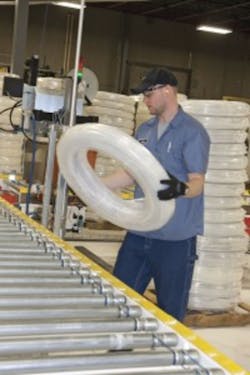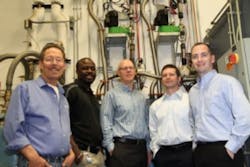Engineers looked to emerging technology when it was time to replace 12 dosing pumps at an Uponor Inc. facility that manufactures crosslinked polyethylene (PEX) piping. They were searching for something that could modernize the facility’s production process and improve consistency — and that’s what they found for the company’s manufacturing operation in Apple Valley, Minnesota.
A heated head-dosing pump, only available in Europe, enabled designers to reconfigure the production process and realize manufacturing and quality efficiencies beyond expectations.
Producing PEX
PEX is a flexible and corrosion-resistant product with distinctive properties and durability used for plumbing, radiant heating/cooling and fire safety systems. In Uponor’s PEX-a type tubing, the crosslinking is performed during the manufacturing process when polyethylene is in its amorphic state above the crystalline melting point. Because of this, the degree of crosslinking reaches around 85 percent. This is higher than PEX-b or PEX-c and results in a more uniform, flexible product with no weak links in the molecular chain.
The PEX-a production process combines additives with the original base resin. The bulk additives arrive at the 130,000-square-foot manufacturing operation often in a solid form, but they must be liquefied to blend properly and cure into the final substrate. To ensure proper movement through the production process, the product solution must be heated to the appropriate temperature.
Maintaining the flow
The Apple Valley plant has multiple mixing lines, in which the polyethylene resin is mixed with the liquefied ingredients that are metered through precision dosing pumps. Once the additives have been blended, the molten mix is pumped to a hopper for curing before being sent to the extruder. Since 1990, the plant has used external heat-trace cable on the production piping and pump heads to keep the additives in a liquid state.
"The heat-trace cable was wrapped around the pipes, as well as around the pump heads," said Uponor Process Engineering Manager Aaron Bahner. "Then, the whole thing was covered in foam insulation and wrapped with tape. It was a mess."
Bahner said that the system was not reliable. The heat-trace cable wrapping would occasionally deteriorate the foam or tape, causing a short circuit that in turn caused the resin mix to cool and solidify. The result was loss of an entire batch of product, along with extended downtime while the system was thoroughly cleaned and new heat trace applied.
The Uponor engineering team had long wanted to replace the heat-trace cable with a more reliable internally heated pipe technology, but this required a rare precision dosing pump with a fully integrated heated head.
Uponor’s Dave Buchanan displays a roll of the PEX piping used for plumbing, radiant heating/cooling and fire safety systems.
Accuracy and repeatability
As the solution, the team chose a 145-psi hydraulic dosing pump with a heated, stainless-steel head. It is used in many European process engineering applications and has a repeatable accuracy of ±1 percent, an improvement above the industry average of ±3 percent.
Uponor Engineering Project Manager Richard Peick said that repeatability is critical in this type of exacting process. If the formula calls for each pump to inject 1 milliliter of fluid into the mix with each piston stroke, it must deliver that amount each time to ensure a consistent product.
Peick contacted a global pump manufacturer in late 2013 to inquire about the heated dosing pump. At that time, the pump was available only in Germany, but the manufacturer agreed to customize it to American specifications for Uponor. The pump company’s OEM project manager and district sales manager visited the Apple Valley plant in January 2014 to work out project details.
The required pump customization included upgrading the pump’s cartridge heater from 50 to 100 watts to heat it more quickly, as well as reconfiguring the power supply for U.S. voltage.
Despite this customization, the final cost per pump was $7,000 less than the nearest competitor — a savings of about 50 percent.
Heated solution
Richard Peick, engineering project manager, Uponor Inc.; Max Davis, process engineer, Uponor Inc.; Aaron Bahner, process engineering manager, Uponor Inc.; Joe Zenner, district sales manager, Grundfos Pumps Corporation; Brandon Guimont, outside sales manager, PFC Equipment Inc. Courtesy of Grundfos
With a heated-head pump that met exacting dosing standards in place, Peick and his team needed to find a way to maintain the heated solution from the initial dosing pump throughout the manufacturing process to improve production quality and consistency. They found that electrically heated hoses that use a Teflon core surrounded by a built-in heat coil, according to Brandon Guimont of PFC Equipment, is far more dependable than the external heat trace. PFC is a Maple Grove, Minnesota-based fluid handling distributor that worked with Uponor on the installation.
Uponor took delivery of the first pump in August 2014 and completed the upgrade at the end of 2015.
As expected, the new heated pumps and hoses have made the mixing process faster, more stable and more consistent. "The fluid is viscous like molasses," said Peick. "When there were temperature inconsistencies in the manufacturing line, there would be thinner and thicker spots, which meant that the operator had to manually compensate by adjusting the amount of additives used."
Increased output, lowered expense
This dosing pump was used in the Uponor manufacturing facility.
Because the new system keeps the fluid at a stable temperature and consistency, it brought about faster and more consistent process speeds. According to Bahner, this boosted throughput meant that each line could produce about 15 percent more product during a given time period.
That production increase meant that the project’s return on investment was higher than expected. Other unexpected benefits that cut costs and headaches included:
- Fewer pumps. The more uniform mix, along with the new pump’s dosing accuracy, increased the plant’s output while halving the number of pumps needed. "Instead of needing two pumps to meter each ingredient, we were able to consolidate this volume into one pump, thanks to the heated-head and dosing precision," said Peick. Overall, the company replaced the 12 original pumps with six of the new units, which halved what they anticipated spending on pump equipment.
- More compact system. Eliminating pumps and adding mixing decreased 50 percent of piping and fittings compared to the old line. This reduced capital costs and space requirements further.
- Better control. The new pumps and heated hoses are part of a computer control of the entire system, something that wasn’t possible with the old pumps and the heat trace. Now, the production formulas are entered into the system, and it essentially runs itself. "The dosing is all automatic," said Peick. "We no longer have to depend on the operator to get it right. It’s dialed in." That higher level of quality control also allows more accurate troubleshooting. "If the mix in part of the system is starting to cool, we get an alarm telling us exactly where the problem is," said Peick. "With the heat trace we didn’t have that capability."
- Less maintenance. Replacing the unreliable heat trace eliminated the need to clean failed lines and throw away the hardened mix in those failed lines. "We were spending about 100 hours per year on maintenance with the old system," said Peick. "The new system has been in place for six months, and I can count on one hand the number of maintenance hours needed. It’s a drastic reduction in time, effort and frustration."
End game
All in all, the new pumps have increased output and reduced expense and aggravation, making the manufacturing process more reliable and profitable.
In late 2015 Uponor opened an additional 88,000 square feet of PEX-manufacturing space adjacent to the current facility, and the new heated production process was the new standard, according to Peick. The company is also considering incorporating the new production process in its other locations worldwide.
Jay Stellmacher is the vice president of industry sales for Grundfos USA. He may be reached at [email protected]. For more information on this pump technology, visit grundfos.us.




